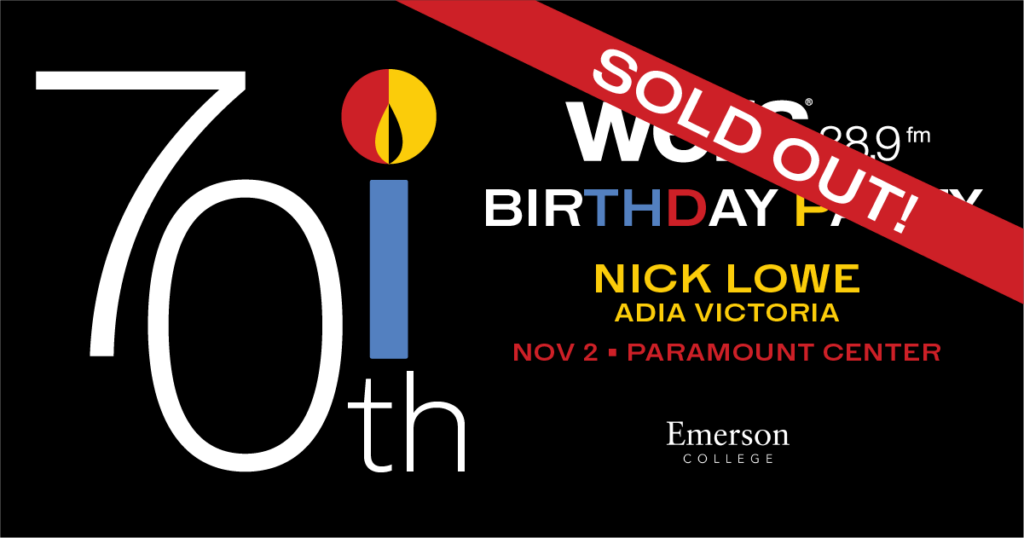
By Fenton Wright, Staff Writer
Each week of Black History Month, WERS is bringing you an in-depth account of the legends who built soul as we know it today. On this week's Vault of Soul, 'ERS is admiring the man who brought sexiness to the soul scene: Teddy Pendergrass. Stay tuned for next week's deep dive!
Biography
Teddy Pendergrass was born in Kingstree, South Carolina on March 26, 1950. The majority of Pendergrass’ childhood, however, was spent in North Philadelphia. His father left the family when Pendergrass was very young, and his mother promised that the two would meet one day, fulfilling that promise around the time that Teddy was 11. Pendergrass grew up singing in the churches that his family attended. It was in those churches that he learned to not only sing, but play the drums. Pendergrass was not determined to make it in the music industry until his junior year of high school, when he dropped out and focused on his career as a musician.
The Blue Notes
Just after he dropped out of high school, Pendergrass released his debut single, “Angel With Muddy Feet.” Despite young Pendergrass taking a chance on himself, the song flopped. This relegated Pendergrass to working as a drummer across the Philadelphia music scene. He would work for various bands across the city. It was not until Harold Melvin, the founder of the group Harold Melvin and the Blue Notes, that Pendergrass found a permanent band to play with. On one of their performances, Pendergrass, at that point just the drummer of the group, began singing along with Melvin. From that point on Melvin made Pendergrass the lead singer of the group, and the group was on the fast track to success. They released hits such as “If You Don’t Know Me By Now,” and “I Miss You,” which both gave them the mainstream success in the R&B scene that they had been searching for. As they began to do more and more shows, Pendergrass grew frustrated with his role in the band. Despite being the lead singer, people associated the group with Harold Melvin, and not Pendergrass. This led to his split from the group in 1975.
Just Teddy
After his split from the Blue Notes in 1975, Pendergrass began working on his self-titled debut album, Teddy Pendergrass. It featured hit songs such as the platinum single, “I Don’t Love You Anymore.” On other songs including "And If I had," and "The Whole World's Laughing At Me," and "Easy, Easy, Got to Take It Easy", Pendergrass dialed into a vulnerable and easy going sensual energy not heard with many of his contemporaries.
Teddy Put Sexiness Into 70's Soul
Shortly after the release of his debut album, he released, Life Is A Song Worth Singing, in 1978. With this effort, Teddy took on the persona of a leading man/sex symbol. Starting with his debut album in 1977, Where his first album left some doubt of where his intentions were, his 1979 sophomore release, “Teddy,” got directly to the Teddy Bears point.
The album included Quiet Storm staples such as the “no-doubt what we're here for” anthem, "Close The Door," "Turn Off The Lights," and the rare groove "All I Need Is You." These songs tenderly gave his audience both a romantic fantasy blueprint and were inspirational mood setters. Combining Pendergrass' dynamic, raspy low vocals with Philadelphia International soul music legends such as Leon Huff, Thom Bell and Kenny Gamble and the recipe for super sexy symbol status was solidified. His third album released in 1981 was set along the backdrop of declining disco sales. The aptly titled, It's Time for Love, featuring the hit "You're My Latest, My Greatest Inspiration," would further cement his grasp within the soulful R&B genre. With records that set the mood, Teddy upped his seductive showmanship with concerts designed with just the ladies in mind.
Pendergrass launched a "Ladies Only" Tour. Pendergrass would literally pour his entire heart and soul into performances dripping with soulful pulsating sweat. Legendary tour memories are filled with audience members sharing more than just smiles with Teddy… Predominantly female audiences would hurl their intimate apparel and phone numbers to him. This set the tone for numerous acts to follow throughout the following decades. Of note, 1990's artists such as Jodeci, TGT - Tyrese Ginuwine and Tank and 2000's shows featuring Joe, Janet Jackson and Miguel owe a debt to the on stage seduction Pendergrass put in motion.
The start of his solo career was off to a hot start following those two releases. Teddy moved further and further into the mainstream of R&B. Every new hit cemented him as a mainstay in the Soul and R&B genres, achieving either gold or platinum certification and propelling him to sell out big concert venues. Pendergrass’ hits during this period of his career were “Love TKO,” “When Somebody Loves You Back,” and many more. He became the face of soul, surpassing many of the greatest artists of the genre on his rise to stardom. Pendergrass was even an inspiration to some of his peers, such as Luther Vandross. His influence and popularity continued to grow until his devastating car accident in March 1982, which paralyzed him from the chest down. Teddy Pendergrass would never walk again.
More Than A Comeback
After his accident, Pendergrass had much more pressing matters to attend to outside of releasing new music. Although severely injured, his sixth studio album, This One’s For You, was released in the summer of 1982. This album along with his October 1983 release of Heaven Only Knows saw Pendergrass release songs that had been performed before his accident. In 1984, Pendergrass recorded another album called Love Language featuring the singles, “You’re My Choice Tonight,” produced by Luther Vandross and a duet, “Hold Me” with Whitney Houston. Pendergrass would return to the stage in his hometown of Philadelphia on July 13, 1985, at the Live Aid concert. It was a truly triumphant moment. Just three years earlier, in 1982, Pendergrass almost died, and to see him on stage in front of an estimated 1.5 billion people worldwide was a testament not only to his stardom, but his strength as a human.
After the Live Aid concert, Pendergrass continued his career. He performed on songs with the likes of Whitney Houston and Stephanie Mills. By the end of the 1980s, the singer had fully cemented himself as a titan and icon of music, with his final album being released in 1998. Pendergrass would go on to perform at various venues up until 2006 when he formally retired from the music world. The soul icon would later pass away from respiratory failure in 2010. Despite his passing, his legacy still lives on today with the Enon Baptist Church Youth Fund that was set up by his wife Joan Pendergrass in his name. It provides scholarships and other forms of support for the younger members of the church’s congregation.
Who Influenced Teddy Pendergrass?
- James Brown
- Otis Redding
- Marvin Gaye
- Frank Sinatra
- Marvin Junior of the Dells
- David Ruffin of the Temptations
Who Teddy Pendergrass Influenced:
- Usher
- Stephanie Mills
- Whitney Houston
- Johnny Gill
- Al B. Sure
- Tyrese
- Janet Jackson
Teddy Pendergrass’ Awards and Honors:
- American Music Award, Favorite Soul/R&B Male Artist, (1979)
- National Rhythm & Blues Hall of Fame class of 2021
- Rolling Stones no.42 Greatest Singer of All Time
Spotlight Tracks
“Wake Up Everybody” (1975)
The title track for Harold Melvin and the Blue Notes’ November 1975 album was a springboard for Pendergrass’ launch into R&B superstardom. Pendergrass, on the lead vocal seems to summon all of his gospel and pulpit sermon influence to call his soulful community into action nationwide. Bellowing lyrics pleading, “wake up everybody no more sleeping in bed, no more backward thinking time for thinking ahead!” are still anthemic today, reminding both young people and elders to dig deep within themselves to have not only love for one another, but especially love for themselves.
“When Somebody Loves You Back” (1978)
"When Somebody Loves You Back” was released on Pendergrass’ second album Life Is A Song Worth Singing in 1978. Along with other songs on the album, “When Somebody Loves You Back” helped the album attain its platinum certificate and reach number 11 on the US Billboard 200. The song almost fully encapsulates the passion that Pendergrass put into each of his songs. It fills the listener with the story that Pendergrass is trying to tell, that being: what it’s like to be loved and in love with someone. The song starts with very light drumming and an accompaniment of horns and cymbals. Then comes Pendergrass' smooth voice that puts the listener into a trance that can only be described as falling through a world that is the manifestation of the very idea of love itself.
“Close the Door” (1978)
From the same album as “When Somebody Loves You Back,” “Close the Door” is the star of the album. It is this song that gave Pendergrass a true Billboard hit. The song peaked at No.1 on the Billboard R&B chart. On its own, independent of the album, “Close the Door” earned a gold certificate and has been sampled many times over by numerous artists. The song again channels the very essence of the soul genre. The light tapping of the drums, the horn solo in the middle of the song, and of course the vocals of Teddy Pendergrass make this track feel perfect. Every aspect of it reveals what love is about: passion. “Close the Door” and other songs are what established Pendergrass as the romantic love icon that he was and helped supercharge his career.
“Love TKO” (1980)
This song is from his fourth studio album, TP. For this song, Pendergrass covers a soul classic in ‘Love TKO.’ He keeps the composition of the song mostly the same, but of course, no one has done it like Pendergrass. The song has a smooth bassline underlying the drums and piano. Pendergrass adds his voice to it, which is just that much smoother than anyone who has covered the song before him and after him. He truly makes it his own, and it is widely considered to be his song despite the many versions of it. Safe to say, it was a knockout with audiences seeking romance and solidified Pendergrass as both a singer and sex symbol.


